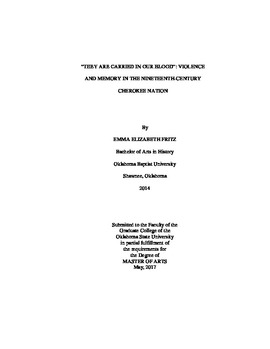| dc.description.abstract | Throughout the nineteenth century, the Cherokees faced unequivocal levels of violence. They experienced unmatched terror at the hands of others and themselves. Death, destruction, and hatred ran rampant in the Cherokee Nation among its peoples and leaders. However, their traditions allowed them to maintain the strength and cohesiveness of their tribe throughout the worst of the violence they faced. Leaders worked to unify and renew the tribe following excessive violence. To determine the best course of action, leaders and peoples alike continuously turned to the past for guidance. The Cherokees’ ability to internalize violence and allow it be a renewing force, and to use memories to promote their future, enabled them to persist through one of the most turbulent periods in their history.Removal emphasized the schisms that already existed in the tribe and only heightened upon arrival in Indian Territory with the assassination of the Treaty Party. A seven-year civil war and forced peace agreement resulted in moving the tribe into their Golden Age of the 1850s. The American Civil War, though, returned violence to the nation resulting in two political parties representing the schisms in the postbellum period. Throughout these affairs, the Cherokees utilized their practice of making violence regenerative, commonly entering a time of prosperity following excessive violence. They also returned to their past to promote their future by implementing the practices of those before them.More importantly, though, is that these two elements propelled the other forward, creating a tribe that was able to contend with internal schisms, violence, external pressures, and changes throughout a century in an increasingly encroaching world. The Cherokees’ ability to internalize violence and maintain connections to those before them allowed them to conserve their strength and autonomy through removal, the Treaty Party assassination and resulting Civil War, the Golden Age, the United States Civil War, and rebuilding during the postbellum period. Although both important practices of the tribe, the ways in which violence and memory worked in tandem in Cherokee history reveal the reasons the tribe has endured for centuries in contention with surrounding powers. | |
